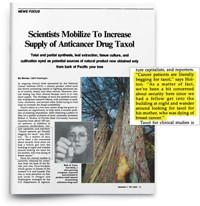Advertisement
Grab your lab coat. Let's get started
Welcome!
Welcome!
Create an account below to get 6 C&EN articles per month, receive newsletters and more - all free.
It seems this is your first time logging in online. Please enter the following information to continue.
As an ACS member you automatically get access to this site. All we need is few more details to create your reading experience.
Not you? Sign in with a different account.
Not you? Sign in with a different account.
ERROR 1
ERROR 1
ERROR 2
ERROR 2
ERROR 2
ERROR 2
ERROR 2
Password and Confirm password must match.
If you have an ACS member number, please enter it here so we can link this account to your membership. (optional)
ERROR 2
ACS values your privacy. By submitting your information, you are gaining access to C&EN and subscribing to our weekly newsletter. We use the information you provide to make your reading experience better, and we will never sell your data to third party members.
Pharmaceuticals
From The Ocean To Patients
by Lisa M. Jarvis
October 8, 2007
| A version of this story appeared in
Volume 85, Issue 41
Marine bioprospecting, or panning for drugs in the sea, is an intriguing concept, but to date, it has yielded few actual therapies. More often, what it has done is help chemists translate the promise of nature into viable drug candidates. The stories of two marine-inspired products that are heading toward commercialization illustrate how scientists are learning to overcome past challenges.
PharmaMar, a Spanish company dedicated to probing marine sources for their cancer-fighting potential, is the closest to bringing a marine product to market. A drug the firm calls Yondelis is awaiting final marketing approval in Europe for treating advanced soft tissue sarcoma and is in a handful of Phase II/III studies in other cancers. Its active ingredient, trabectedin, is found in the filter feeder Ecteinascidia turbinata, more commonly known as a sea squirt.
PharmaMar originally set up an aquafarm in Morocco with the notion that trabectedin could be extracted from the organism, says David Newman, chief of the Natural Products Branch of the National Cancer Institute (NCI). That route, however, proved limiting, and real progress began when scientists developed a semisynthetic method to manufacture trabectedin using a bacterial precursor.
The other compound working its way through the pipeline is eribulin mesylate, an analog of halichondrin B, a macrocyclic polyether found in several kinds of sea sponges. Eisai Pharmaceuticals recently initiated Phase III studies of the drug in advanced breast cancer.
It too has traveled a long road. Originally isolated in 1986, halichondrin B was shown to be active in fighting tumors in mouse models. After putting it into clinical development in the early 1990s, NCI funded the collection of 1 ton of the host sponge, which is found in deep water off the coast of New Zealand. That boiled down to a mere 300 mg of product, Newman recalls, not nearly enough to further develop the drug.
NCI subsequently enlisted Yoshito Kishi, a chemistry professor at Harvard University, to devise the total synthesis of halichondrin B. Kishi's group found that only the "ring half" of the molecule was needed for bioactivity and, working with Eisai, generated a range of analogs. That led to a cooperative program between NCI and Eisai, which in 2002 initiated Phase I trials of eribulin, an analog that displays more activity with less toxicity than halichondrin B.
"When we started doing this, there were not the synthetic chemistry techniques available on a large scale," Newman says. Even fermentation routes were limited, because researchers were hesitant to ferment in salt water. However, today, he says, "depending on the compound and the time frame, any and all of these routes are valid."
- Liquid Gold Mine
- Scientists in Norway are plumbing the seas for the next blockbuster medicine
- Success Stories
- From The Ocean To Patients
- Trondheim Photo Gallery
- Tromsø Photo Gallery






Join the conversation
Contact the reporter
Submit a Letter to the Editor for publication
Engage with us on Twitter